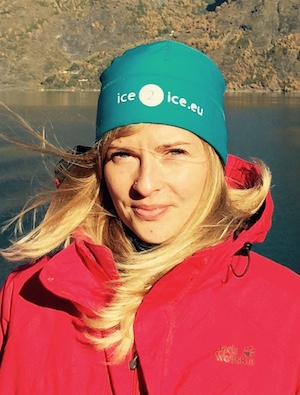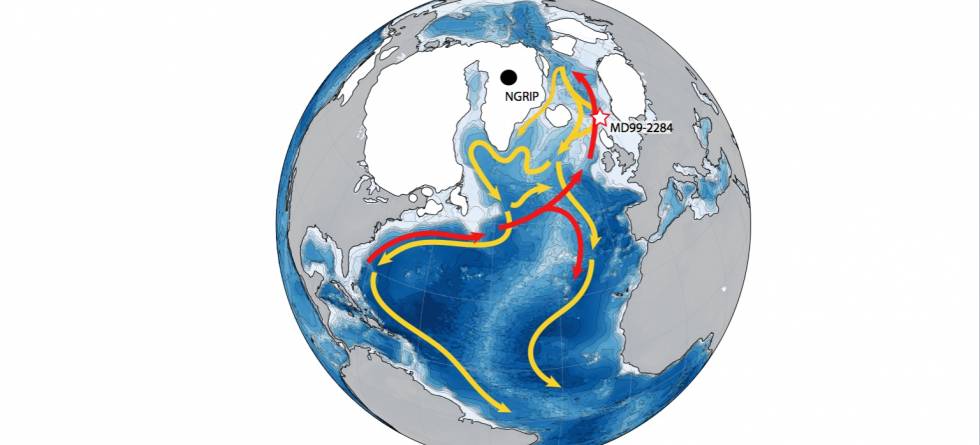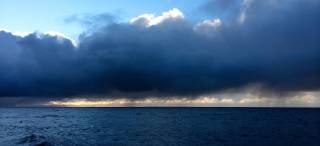Based on press-release by Lamont-Doherty Earth Observatory
In the Atlantic Ocean, a giant ‘conveyor belt’ carries warm waters from the tropics into the North Atlantic, where they cool and sink and then return southwards in the deep ocean.
This circulation pattern is an important player in the global climate, regulating weather patterns in the Arctic, Europe, and around the world. Evidence increasingly suggests that this system is slowing down, and some scientists fear it could have major effects, such as causing temperatures to dive in Europe.
A new study published in Nature Communications provides insight into how quickly these changes could take effect if the system continues weakening. Led by scientists at Columbia’s Lamont-Doherty Earth Observatory in collaboration with the Norwegian Research Centre, the study is the first to precisely determine the time lags between past changes to the AMOC and major climate changes.

“Our reconstructions indicate that there are clear climate precursors provided by the ocean state — like warning signs, so to speak,” says lead author Francesco Muschitiello, who completed the work as a postdoc at Lamont-Doherty and now works at the University of Cambridge.
Leads and Lags
The team studied a key section of the ocean current pattern, known as the Atlantic Meridional Overturning Circulation (AMOC). They zeroed in on a section where water sinks from the surface to the bottom of the North Atlantic. Comparing data from three cores, a sediment core drilled from the bottom of the Norwegian Sea, a lake sediment core from Southern Scandinavia, and ice cores from Greenland, they confirmed that the AMOC started weakening about 400 years before a major cold snap 13,000 years ago, and began strengthening again about 400 years before an abrupt warming 11,000 years ago.
In other words were AMOC weakened in the time leading up to the planet’s last major cold snap, called the Younger Dryas, around 13,000 years ago. The ocean circulation began slowing down about 400 years before the cold snap, but once the climate started changing, temperatures over Greenland plunged quickly by about 6 degrees.
A similar pattern emerged near the end of that cold snap; the current started strengthening roughly 400 years before the atmosphere began to heat up dramatically, transitioning out of the ice age. Once the deglaciation started, Greenland warmed up rapidly — its average temperature climbed by about 8 degrees over just a few decades, causing glaciers to melt and sea ice to drop off considerably in the North Atlantic.
Co-author William D’Andrea, a paleoclimatologist at Lamont-Doherty was surprised by what they found — he says the lag times are two or three times greater than he would have expected.
Comparing ice cores and marine sediment cores
This study is one key in the puzzle to better understand the ocean-cryosphere interactions in the Nordic Seas and their role in shaping abrupt climate change in Greenland during the last deglaciation.

“Precise chronologies and synchronizations with Greenland ice core records are key to understand the timing of interactions of all the components of the climate system in respect to Greenland changes”, says Trond M. Dokken at NORCE and the Bjerknes Centre for Climate Research.
Dokken is one of the leaders in the ice2ice consortium, a larger ongoing ERC Synergy Grant led by four institutions in Bergen, Norway and Copenhagen, Denmark. The Ice2ice project aims to unravel how Arctic and sub-Arctic sea ice cover excerts important controls on past and future Greenland temperature and ice sheet variations.

“This is especially important if we want to make an attempt to understand how comparable (or not) these past dynamics are that led to abrupt sea-ice loss back then and those ongoing and expected in the future happening in the Arctic Ocean” says Margit H. Simon, Senior researcher NORCE and the Bjerknes Centre for Climate Research and co-author on the study.
Radiocarbon dating formed a substantial part of this study, which were prepared at NORCE in Bergen and measured in collaboration with the ETH in Zuerich, Switzerland. Lead author Francesco Muschitiello continues to work closely with the scientists in the ice2ice project in Bergen especially on radiocarbon related matters with both co-authors Trond M. Dokken and Margit H. Simon.
Reference:
Francesco Muschitiello, et al. (2019) Deep-water circulation changes lead North Atlantic climate during deglaciation, Nature Communications volume 10, Article number: 1272 (2019)



